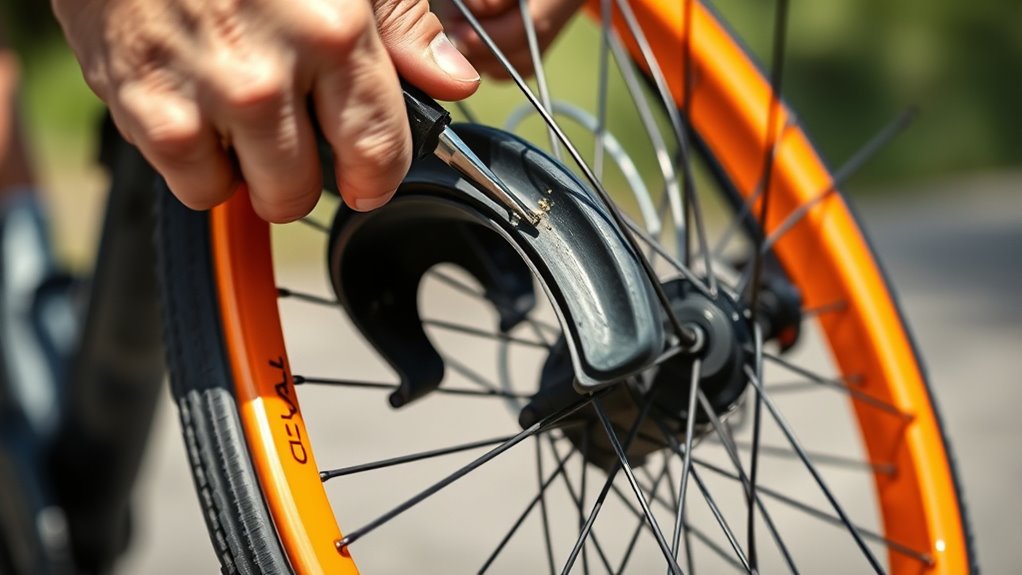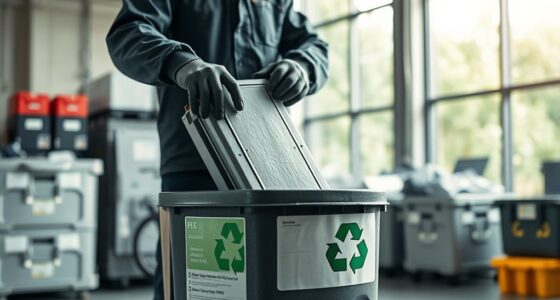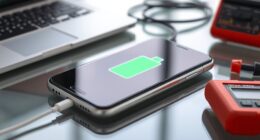To fix a flat on your e-bike, first find a safe, flat spot and remove the wheel using the quick-release lever or tools. Carefully pry the tire away from the rim and inspect the inner tube for debris, cuts, or punctures. Patch the hole with a proper kit or replace the tube if needed. Reinstall everything, inflate to the correct pressure, and test for leaks. Keep going to discover detailed tips to make the repair smooth and quick.
Key Takeaways
- Safely remove the wheel from your e-bike on a flat, flat surface using quick-release or tools.
- Carefully deflate and remove the tire with tire levers to access the inner tube.
- Locate and patch or replace the punctured inner tube, ensuring debris is removed.
- Reinstall the tube, mount the tire securely, and inflate to the recommended pressure.
- Reattach the wheel, check for proper operation, and ensure no leaks before riding.

Ever wondered what to do when your e-bike suddenly goes flat? The first thing to remember is that flat tires happen to even the most seasoned riders, but with a bit of know-how, you can fix the issue quickly and get back on the road. Before diving into repairs, take a moment to assess your tire. Proper tire maintenance is key to preventing flats in the first place. Regularly check your tires for embedded debris, cuts, or wear. Keep your tires properly inflated—under-inflated tires are more prone to punctures and damage. Maintaining the correct pressure not only extends your tire’s lifespan but also reduces the risk of flats, making puncture prevention a essential part of your riding routine.
When you notice your tire is flat, first, remove your e-bike from the riding position and find a safe, flat surface to work on. If your bike has quick-release wheels, release the axle clamps to remove the wheel; otherwise, use appropriate tools to detach it. Once the wheel is free, inflate the tire slightly to help locate the puncture. You can do this by submerging the inflated tire in water or by listening for escaping air. Look for bubbles or listen carefully for hissing sounds that indicate the leak.
After pinpointing the puncture, remove the tire from the rim. Use tire levers to pry the tire away from the wheel carefully. Once the tire is free, locate the puncture site. Inspect the inner tube thoroughly for sharp objects like glass shards, thorns, or nails that might have caused the flat. Remove any debris you find and dry the tube to see the puncture clearly.
Next, patch the hole or replace the tube if necessary. If you’re patching it, roughen the area around the puncture with sandpaper, apply the patch as per instructions, and let it cure. Reinstall the inner tube into the tire, ensuring it’s seated properly, and then mount the tire back onto the rim. Double-check that the tube isn’t twisted or pinched before inflating. Inflate the tire to the recommended pressure—this is a essential step, as proper inflation supports puncture prevention and overall tire health.
Finally, put the wheel back onto your bike, secure the axle, and test your repair by gently spinning the wheel to ensure it moves freely and no bulges or leaks are present. Regularly practicing tire maintenance and being vigilant about puncture prevention can save you time and frustration, making your rides safer and more enjoyable. With these steps, fixing a flat on your e-bike becomes a straightforward task, keeping you rolling smoothly on your adventures.
Frequently Asked Questions
Can I Fix a Flat Tire While Riding?
You shouldn’t fix a flat tire while riding your e-bike because it compromises road safety and bike maintenance. Stopping safely allows you to inspect the tire, remove the flat, and replace or patch it properly. Attempting repairs on the go risks losing control or causing an accident. Always find a safe spot, then repair your flat thoroughly to ensure your bike runs smoothly and safely again.
How Do I Prevent Flats on My E-Bike?
Think of your e-bike tire like a delicate shield—keep it strong and resilient. To prevent flats, regularly check your tire pressure; it should be neither too soft nor too hard. Use puncture prevention liners and avoid debris on your ride. Staying attentive to your tires’ condition and maintaining proper pressure creates a fortress against flats, ensuring smooth, worry-free adventures on your e-bike.
What Tools Are Essential for Fixing a Flat?
You’ll need a few essential tools to fix a flat on your e-bike. A tire lever helps remove the tire, while a pump or CO2 inflator restores the proper tire pressure. Don’t forget a patch kit or spare tube for repairs. Be aware of valve types—Presta or Schrader—as they determine the valve adapter. These tools guarantee you can quickly address flats and keep your ride smooth.
How Long Does It Take to Fix a Flat?
Fixing a flat usually takes about 20 to 30 minutes, depending on your experience. You’ll need to check the tire pressure before reinstalling the tire, ensuring it’s at the right level for your e-bike. While you’re at it, take a moment to lubricate your chain, which helps prevent future issues. With practice, you’ll get faster, making the process smoother and more efficient each time.
Should I Replace the Inner Tube or Patch It?
You should generally patch the inner tube if the puncture is small and in a location that’s easy to access. Replacing the tube is better for larger or multiple punctures, or if the tire’s durability is compromised. Patching helps prevent future punctures and maintains your bike’s puncture prevention features. However, if the damage is extensive or the tube is old, swapping it out guarantees reliable performance and smoother riding.
Conclusion
Now that you’ve tackled the flat, you’re back on the trail like a swift breeze, ready to conquer new horizons. Think of this repair as a badge of your growing confidence—each fix sharpens your skills and keeps your ride smooth. With your tools in hand and a steady heart, you’re the captain of your e-bike adventure. So pedal forward with a grin, knowing you’ve turned a hiccup into a chapter of your biking story.









